Introduction
This paper is aimed at presenting an exploration of the reinterpretations of the stylistic period of the Ancient Greek epitomized in the architecture of the ancient Greece. The study entails the tracing of the patterns and features of the ancient architecture in modern designs. The study will take a significant thrust in analyzing particular architectural designs of ancient Greece as a way of establishing the influence of ancient architecture in contemporary in building.
Present a timeline-based exploration of global architectural history spanning from 3,500 B.C.E to date. The scholars have underscored the significance of “links, influences, and contrasts of the architectural progressions in history” (Francis D.K. Ching et al., 2007). Any attempts at exploring global historical architecture will not be complete without the consideration of the significant influence of Greek architecture on modern building designs.
Existent knowledge of Ancient Greek architecture has been obtained the period of 550-500BC as well as what is known as the Periclean era spanning 450-430 BC. A significant part of the knowledge of ancient Greek building designs and models has also been obtained from the Classical period of 430 – 400 BC. Francis D.K. Ching et al (2007) note, “Some nuances on the characteristics of ancient Greek have been obtained from the Roman architecture which is largely known to have drawn significant influence from Greek architecture.”
Wood was the common material used in Greek building constructions. Wood was used for construction structures such as roof beams. Other forms of matter such plaster were also used in the making of components like sinks as well as bathtubs. For wall structures builders used unbaked brick and for exquisite designs, builders used limestone and marble.
Limestone and marble were also used in palatial temple designs as well as in public buildings. William Rostoker et al (1981) outline, “The Greek are known to be some of very architecturally aesthetic community hence the heavy reliance on material like bronze and ornaments and other metals for decorative building detailing.” Building forms of the Classical period era can be classified into five types of structure which are funerary, recreational, civic, domestic and religious.
Main body
Architectural historians have preserved some of images and drawings of artifacts of various ancient Greek architectural designs viewed as yardsticks for particular ancient Greek architectural categories. One of the highly esteemed relics of Greek History is the artifacts of the ‘Stoa of Attalos’. The Greek term ‘Stoa’ was used in ancient Greek architecture to refer to elements like walkways (known in Greek as porticos) which were made for the public. The Stoa of Attalos is held as one of the outstanding structures of the Athenian Agora. The structure was built under the rule of King Attalos and hence the naming after him.
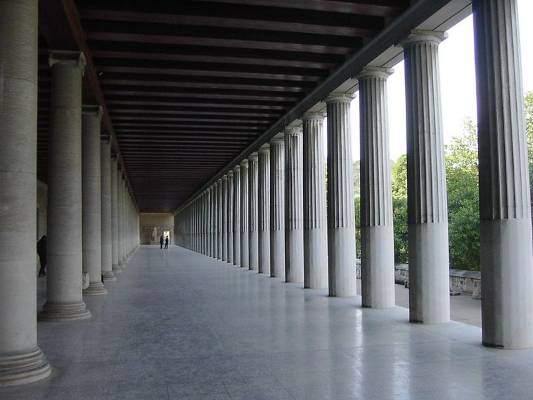
The Temple of Hephaestus in Athens is one of the architectural structures held as the standard designs of Greek public buildings. The Temple of Hephaestus is categorized together with other ‘renoedn’ structures such as the temple complex at Selinunte, the Parthenon as well as the sanctuaries at Agrigentum. Such buildings were embellished with limestone or tuff for aesthetic detailing.
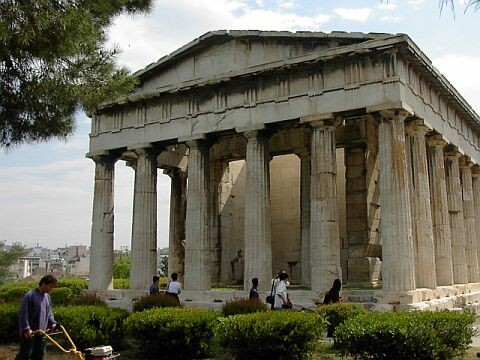
The Greek temples are said to have been the paragons of the Greek aesthetic endowments as the Greeks were a religious community. Greek temples were designed in immaculate magnificence which has earned them recognition as the most outstanding designs of their time. Orjan Wikander (1990) notes, “The endurance of temple designs and their relative harmony have made the designs a de facto crafting influence for the last two millenniums in the architectural tradition of the West”.
On the other hand, the Greek theater designs were also exceptional designs in ancient Greek. These were used for public entertainment where people would come to watch tragedy and comedy performances. The theatres were also used for poetry and musical events. Theaters were usually built on hillsides in the peri-urban settings.
Theaters constituted rows of tired seats structured around the central performance arena known as the orchestra. The ‘skene’ in Greek theater design refers to the low building behind the performance area which was used as the storeroom while also serving as a utility enclose for backstage activity. The “Epidaurus” is one of the most recognized theaters of ancient Greece.
The stadia in ancient Greek architecture also had a central part in cultural relics of ancient Greek architecture. The modern day Olympic Games were born in Greek competitions. Orjan Wikander (1990) adds, “The Minoan Crete, the Mycenaean palaces of Peloponnese as well as Macedonian Palaces of northern Greece are some of the most recognized palaces of the ancient Greeks to date.”
It must be noted that in Classical era The Greece transformed in line with the ideals of democracy hence there were no palaces built for leaders in that period. Ancient Greek architecture has had overwhelming influence in contemporary architecture. Various building structural designs have been evidently modeled under the influence of the ancient Greek designs.
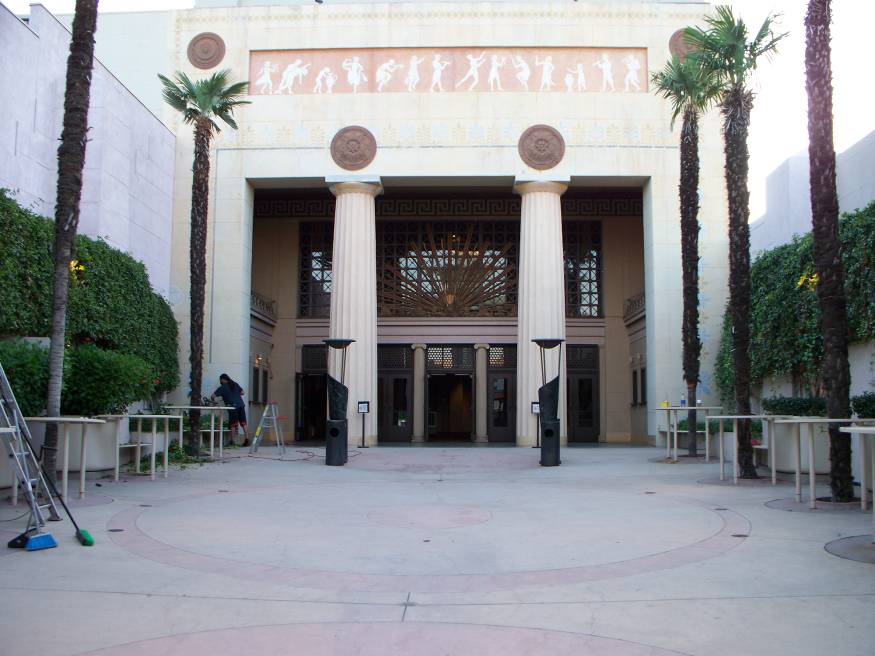
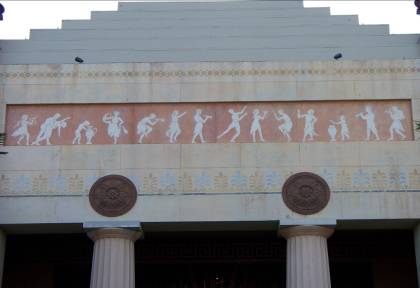
The design of the Alex Theater formerly known as The Alexander entails outstanding elements relatable to Classical Greek as well as Egyptian architectural histories. The massive Doric columns as well as the frieze of Egyptian dances are undeniable resemblances of the elements of the Ancient Greek and Egyptian theater designs.
See et al. (1965) note, “The unique and exceptional interior has remarkable neo-classic Greek and Egyptian architectural adaptations, related to the Greco-Egyptian period of Ptolemaic Egypt.”. The scholars also outline that, “The protracted walkway and courtyard distinguishing the ticket enclosure from the lobby was adapted from the famous Grauman’s Egyptian Theatre in Hollywood.”

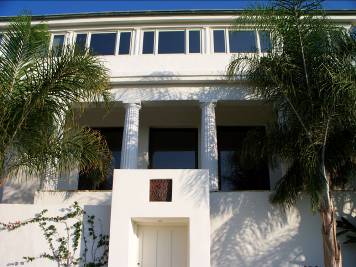
This building was built for pioneering woman film director Dorothy Arzner. Eclectic residence feature includes a second-floor Doric-colonaded loggia. The pervading rectangular shape of the building resembles the ancient Greek temple designs. One striking aspect on the Arzner/Morgan Residence related to the typical Greek architectural colonnaded portico of columns which surrounds the building.
Arzner/ Morgan Residence structure thus closely resembles the structures of the Temple of Athena Nike and the famous Parthenon. William Rostoker, (1981) notes, “In Ancient Greek building designs some designs constituted projecting head of columns making up the entrance ( known as the prostyle) while others were complement by what called the ‘pronaos’ façade of columns protracting to the ‘cella.’ There are striking similarities in the column structures of the two building designs, the Arzner/Morgan Residence and the famous Parthenon displayed below.
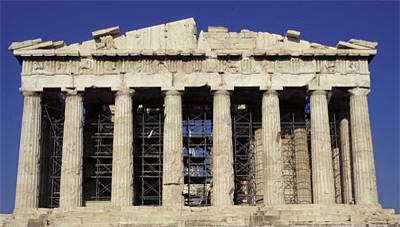
The Parthenon foundation was made of limestone while on the hallmark columns were made of marble. Architects of the famous structure are known to be Iktinos and Kallikrates, Vitruvius, and Karpion. The Parthenon was dedicated to the goddess again demonstrating the acute religious inclination of the Greece.
Francis D.K. Ching et al (2007) note, “The Temple was modeled in resemblance of the ‘Doric order’ marked by the hallmark eight columns at the front as well as seventeen other columns on the sides in tandem with designated ratio of 9.4.” According to the insights of the scholars, “This ratio was a salient design framework for the vertical and horizontal structuring of the building as well as other proportionalities of the design which included the spacing of the columns and the establishment of their height.”
It is notable that the design of the Arzner/ Morgan Residence has overwhelming features of resemblance to the Parthenon design. The architects of the modern structure must have relied closely of the ancient architectural models to erect the residence and tailor it in profound reminiscence of the famous Parthenon temple.
One such structure relatable to Ancient Greek architecture is the legendary Greek Theater. The Greek Theater which was erected in 1929 is modeled is unmistakable resemblance of the ancient Greek theater which in the olden Greek times were normally built on hillsides of the urban territory thresholds. Remarkable aspects of the Theater built on 1929 include the lack of a facade and seating arena design which is closely related to the interior designs of the ancient Greek theater.
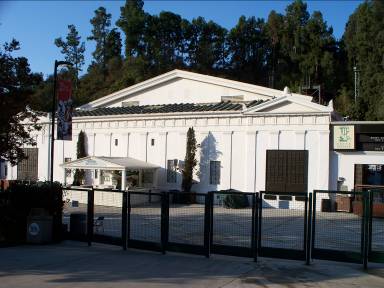
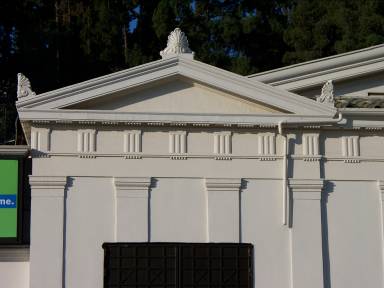
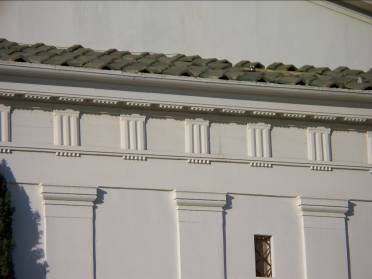
The Greek Theater built in 1929, rightfully named after its typical ancient Greek architectural model, is an over 5000-seat amphitheater situated at the Griffith park in Los Angeles California. One of the theater’s design elements that resemble ancient Greet building structures is the amphitheater stage which closely typifies the ancient Greek temple. The Theatre is structured as serene outdoor theatre in the scenic nature-environment setting.
The striking feature about that location of the theater is that it is nestled within the environs of typically hilltop setting which unmistakably resembles ancient Greek theaters which were normally located around urban area hillsides. Like the olden times Greek theater the Legendary Los Angeles Theater is used as a venue for all kinds and creed while playing venue to numerous big names in the entrainment circles.
Conclusion
The influence of ancient Greek Architecture is far-reaching and can be traced in various building and architectural models the world over. In the US alone evidence of the influence is overwhelming. The Pediments, Doric, and Iconic column elements used in the Capitol Building and the White House in washing D.C. are some of the numerous exhibits of the influence of Greek architecture in modern architecture.
The remarkable and hallmark Greek architectural Corinthian style of column construction is evident in numerous church and state buildings across the world. The dentils pediments as well as friezes with the associative aspect of proportionality and symmetry are unmistakable relics of the substantial influence of Greek architecture in modern building designs.
References
Francis D.K. Ching, Mardk M. Jarzombek, and Vikramaditya Prakas. A Global History of Architecture, Hoboken, NJ : John Wiley & Son, 2007.
G. M. A. Richter, Handbook of Greek Art, Millennium Press, 1967.
Marilyn Y. Goldberg, “Greek Temples and Chinese Roofs,” American Journal of Archaeology, Vol. 87, No. 3. 1983.
Orjan Wikander, “Archaic Roof Tiles the First Generations,” Hesperia, Vol. 59, No. 1. 1990.
Quenell, Marjorie and C.H.B., Everyday Things in Ancient Greece. New York, G.P. Putnam’s Sons, 1954.
Scranton, Robert L., Greek Architecture. New York, George Braziller, 1985.
See J. D. and A. B. Beazley, Greek Sculpture and Painting, Oak Books, 1965
William Rostoker, Elizabeth Gebhard, “The Reproduction of Rooftiles for the Archaic Temple of Poseidon at Isthmia, Greece,” Journal of Field Archaeology, Vol. 8, No. 2. 1981